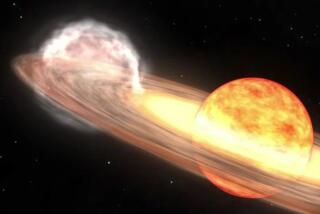NASA poised to launch Orion spacecraft
- Share via
reporting from Kennedy Space Center — Atop the most powerful rocket available, NASA’s next-generation space capsule Orion is scheduled to launch this morning from Cape Canaveral Air Station.
The planned 4:05 a.m. PST blast-off was delayed first because of a boat in a restricted area that had to be moved and later because of ground wind gusts. Liftoff was rescheduled for 4:55 a.m. but delayed again because the winds picked up.
Launch was then rescheduled for 5:26 a.m. PST.
Even so, NASA officials said they were confident that Orion, which has a two-hour, 40-minute launch window until 6:45 a.m. PST, would hurtle into space today.
In nearby Space View Park in Titusville, Fla., about 250 people were anxiously awaiting the start of the mission.
Hannah Marlow of Orlando said she made the trek to witness history. She said she hoped the launch would help encourage her generation to get involved in space.
“It’s a great moment for younger people,” said Marlow, 25.
The 4 1/2 hour, unmanned mission will give NASA a chance to test America’s new workhorse spacecraft. In coming decades, Orion is expected to carry astronauts deep into space: to the moon, asteroids, Mars and beyond.
This flight will give NASA and Orion’s builder, Lockheed-Martin, critical information about how Orion jettisons parts of the rocket as it goes up; how aviation controls and computers function; and how electronics hold up in deep-space radiation.
Also being closely watched will be how its heat shields work as re-entry temperatures reach 4,000 degrees; and if its three sets of parachutes make the landing safe enough for humans.
Orion is set to orbit Earth twice, swinging out to 3,600 miles away – farther than any spacecraft designed to carry humans has gone since Apollo. From there it will reach a re-entry speed of 20,000 mph and splash down in the Pacific Ocean about 600 miles west of Baja California, Mexico.
“Thursday is a huge day for us, flying Orion. It’s the beginning of exploration,’ said NASA Orion Program Manager Mark Geyer.
“A part of me hopes everything is perfect. We land, high-fives; everybody has a great time,” Geyer continued. “But really … we want to discover things that are beyond our modeling capability and beyond our expertise, so we can learn how to fix it.”
Orion’s launch may be drawing more attention than anything that has happened at Kennedy Space Center since the last space shuttle program’s last mission in July 2011. Journalists from around the world have gathered.
Area hotels reportedly have seen a significant spike in bookings.
Space industry insiders are as excited as anyone.
“Go, Big O, go!” said Ron Fortson, United Launch Alliance’s director of mission management
More to Read
Sign up for Essential California
The most important California stories and recommendations in your inbox every morning.
You may occasionally receive promotional content from the Los Angeles Times.













